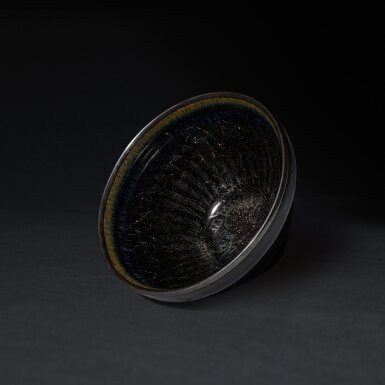
The MQ Collection 莫勸齋珍藏
A very rare Yulinting gilt-inscribed black-glazed 'Beiyuan xianchun' tea bowl, Southern Song dynasty 南宋 遇林亭窰黑釉金彩「北苑先春」茶盞
Lot Closed
October 18, 04:20 AM GMT
Estimate
300,000 - 500,000 HKD
Lot Details
Description
The MQ Collection
A very rare Yulinting gilt-inscribed black-glazed 'Beiyuan xianchun' tea bowl, Southern Song dynasty
莫勸齋珍藏
南宋 遇林亭窰黑釉金彩「北苑先春」茶盞
d. 11.2 cm
Collection of Liu Liang-Yu (1946-2006) , acquired in the 1980s.
慎德堂,台北
劉良佑(1946-2006年)珍藏,得自1980年代
劉良佑(香名天之南,1946-2006年)自1970年起於台北故宮博物院任職,從事文化研究工作,曾擔任台灣現代陶瓷藝術學會首任會長,是台灣著名古陶瓷研究專家及兩岸公認的香學研究第一人。
Bowls with this exquisite dappled black glaze are among the most celebrated products of the Song dynasty (960-1279) kilns at Jian and surrounding areas, in northern Fujian province. The desirability of these bowls coevolved with the tea-drinking tradition of the period.
Yulinting kiln in Fujian province was known to produce some of the finest black-glazed teabowls and were classic vessels for tea consumption in the Song dynasty. Extant tea bowls produced from the Yulinting kiln are particularly rare.
At that time, Chan Buddhist priests prepared, imbibed, and served tea for its beneficial effects on the body and mind. The elaborate preparatory process — which involved scraping tea from a pressed cake, drying it, grinding it, putting it through a sieve, selecting the finest resulting powder, mixing it into a paste with warm water, and gradually adding additional water while simultaneously whisking it into a frothy beverage—played a central role in religious ceremonies. It also became fashionable in elite social circles. Sacred and secular enthusiasts alike sought to master the art of tea-making, with praise awarded to the person who achieved the richest froth.
The intrinsic qualities of black-glazed bowls made them particularly suited for tea preparation and enjoyment. In size and form they were comfortable to hold. Their heavy potting had an insulating effect, keeping the tea inside hot while protecting the fingers from the heat. The speckled jet-black glaze of the present bowl subtly imbued with its distinctive gilt decoration, mimicking the ‘hare’s fur’ glaze of its Jian counterpart. The resulting spectral colouration of refracted light would have greatly heightened the aesthetic experience of a well-formed white froth.
The inscription on the interior of this bowl also reinforces the sophisticated custom of tea appreciation during the Northern Song dynasty. It may be worthy of note that these bowls were made in the same province as the empire’s prized teas, providing another link between the vessel and its contents. Beiyuan refers to the Northern Song dynasty imperial tea plantation in Mount Phoenix, present-day Jian’an county of Fujian province. Zhou Jiang's Sequel to The Classic of Tea [Bu Cha Jing] once noted,
‘Of all the teas in the world, Jian is the best; Beiyuan in Jian is the best of the best.’
Tribute teas from Beiyuan was traditionally divided into ten tiers, all produced from top-quality tea buds compressed into the classic ‘dragon and phoenix tea cakes’. These were then packaged and bestowed with different names and presented to the court. Xianchun literally translates to ‘early Spring’, it is a name of the tribute tea. The Song dynasty poet Yang Yi (974-1020) once asserted his admiration for the xianchun tea in his poem Youyi Jiancha dai Xuanbi bieshu,
‘Xianchun tea from Beiyuan is my usual offering to replace the moonlight in the mountains’.
The notoriety of Jian bowls quickly spread to Japan via Japanese Zen Buddhist monks who travelled to the monasteries of the Tianmu (‘eyes of heaven’) mountain range, west of Hangzhou (Zhejiang), where the bowls were used by local monks for drinking tea. The Zen monks were so impressed by the visual, tactile, and functional qualities of the bowls that they brought them back to Japan in order to use them for the same purpose and dubbed them temmoku (or tenmoku), the Japanese pronunciation of Tianmu, in honor of the place where they first encountered them. Once in Japan, the bowls were adopted by Japanese tea masters and contributed significantly to the development of styles within the Japanese tea ceremony. Consequently, temmoku has become the universally accepted term to describe these nacreous black wares.
Although in China the production of black-glazed tea ware began to decline in the Yuan dynasty (1279-1368), with kilns converting to the production of qingbai-type wares, in Japan whipped tea continued to be ritually prepared and consumed in the tea ceremony. There, temmoku tea bowls were admired and treasured for centuries to come. They were incorporated into family traditions of densei, the passing down of cherished objects to the next generation within a lineage, and accrued prestige with each subsequent transmission. Within the densei system, Song dynasty ceramics were particularly valued. To accord with their exalted status and brilliance, temmoku tea bowls were sometimes paired with ancient mother-of-pearl inlaid or cinnabar lacquer stands, such as lot 611 in this sale.
A closely related example from the Songde Tang collection, gilt-inscribed with the characters Shoushan fuhai (Mountain of longevity and sea of fortune), was included in the exhibition The Multiplicity of Simplicity - Monochrome wares from the Song to the Yuan dynasties, University Museum and Art Gallery, The University of Hong Kong, 2012, no. 109 and sold in Christie's Hong Kong, 3rd December 2021, lot 2832; and another from the British Museum, London (inv. no. 1973,0726.265). Compare also ten Yulinting gilt-decorated tea bowls of various designs, included in the Tang and Song ceramic tea ware exhibition, K.Y. Fine Art, Hong Kong, 2015, nos 24-33.
閩北有窰,宋燒黑瓷,釉面盈潤光潔,纖俊秀逸,迎光而視,頓挫明滅,人盡惜之。遇林亭窰隸屬建窰系之一,為宋代重要窰址,所產烏金釉盞堪稱一絕,傳世品極罕,珍稀非常。
黑釉盞之盛,應源於宋代品茗傳統。宋時禪僧尤奉茶事,飲茶以靜神養身。時人飲茶,先刮茶餅取粉,微烘細磨後篩煉提精,繼著少水調攪,再注水並以筅擊拂至起湯花,以花多且久不散者為上。自北宋始,文人雅士,時常詠頌建窰黑盞,謂之賞茶佳器。如黃庭堅、楊萬里、蘇東坡等,或詠其紋,或讚其形。時至南宋,都城南遷,更近產地,尚建之風繼盛。
黑盞謙素內斂,胎體厚重,舉而不燙,茶溫久恆,釉色沉黑,注茶擊拂,起白花,便於觀色,故為鬥茶絕品。本品出自遇林亭窰,施釉垂厚,色凝亮,巧施金彩,輝若錦鱗,灑作般般雲絲,光射處,幻變銀光,滿目皆然,當屬上品。
盞心底部書有「北苑先春」四字,楷體端正,書法俊秀。「北苑」乃北宋皇家茶園,位於福建建安縣鳳凰山。周絳《補茶經》有載:
「天下之茶,建為最,建之北苑,又為最。」
北苑貢茶分為十綱,均為頂級芽茶所製龍鳳團餅,形式品名各異,皆上貢御用。「先春」則為貢茶名稱。宋代詩人楊億(974 - 1020年)於《又以建茶代宣筆別書》曾頌:
「輒將北苑先春茗,聊代山中墮月毫一絕。」
本盞銘「北苑先春」四字,即為頌揚北苑貢茶而造。
杭州以西有山,名為天目山,山中寺僧以建盞飲茶,時日本禪宗僧人至此,得建盞,甚為珍之,即攜其而歸,深受推崇,謂之「天目」,對後世日本茶道影響深遠。
自元代起,各地窰廠始燒青白等瓷,故建窰系日趨衰落。而日本茶道則仍然保留點茶傳統,奉黑盞為瑰寶,加以鑒賞珍藏,並配嵌螺鈿或剔犀盞托(如本拍賣拍品編號611)。
相類遇林亭窰黑釉金彩茶盞有見於各大收藏,如頌德堂藏一例,金彩銘壽山福海字,曾展於香港大學美術博物館展覽《大繁若簡 - 宋金元朝的單色釉瓷》,2012年,圖版109,後售於香港佳士得2021年12月3日,編號2832;及倫敦大英博物館藏一例(館藏編號 1973,0726.265)。尚可參考香港繼遠美術2015年舉辦《唐宋陶瓷茶具展》展覽十件遇林亭茶盞,編號24-33,當中四件銘有朱熹「九曲櫂歌」詩及繪武夷山水、其餘六件各型各式,包括有銘「壽山福海」、「貢餘龍焙」字,及飾有孔雀紋、竹葉花卉紋、七瓣花卉紋和八瓣花卉紋。
You May Also Like










![An iron kogo [incense box] and cover, Japan, Edo period, 19th century](https://dam.sothebys.com/dam/image/lot/d00dcd4f-790b-4031-9bb0-60bc0d870b02/primary/extra_small)